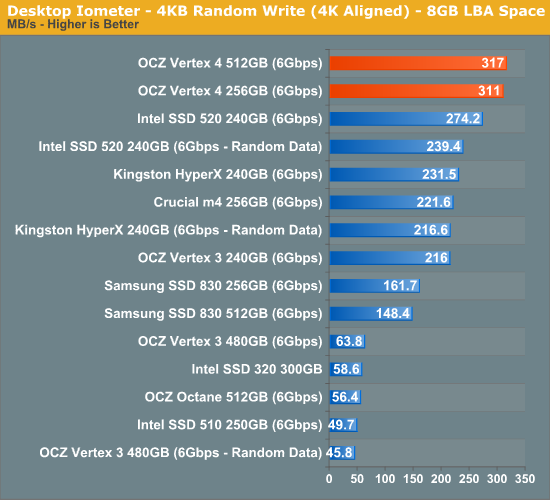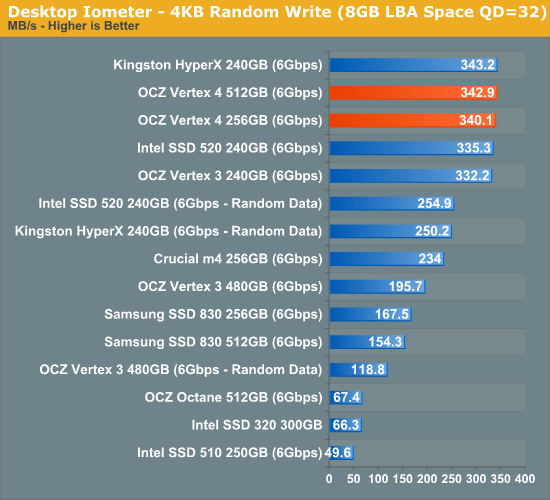OCZ Vertex 4 Review (256GB, 512GB)
by Anand Lal Shimpi on April 4, 2012 9:00 AM ESTRandom Read/Write Speed
The four corners of SSD performance are as follows: random read, random write, sequential read and sequential write speed. Random accesses are generally small in size, while sequential accesses tend to be larger and thus we have the four Iometer tests we use in all of our reviews.
Our first test writes 4KB in a completely random pattern over an 8GB space of the drive to simulate the sort of random access that you'd see on an OS drive (even this is more stressful than a normal desktop user would see). I perform three concurrent IOs and run the test for 3 minutes. The results reported are in average MB/s over the entire time. We use both standard pseudo randomly generated data for each write as well as fully random data to show you both the maximum and minimum performance offered by SandForce based drives in these tests. The average performance of SF drives will likely be somewhere in between the two values for each drive you see in the graphs. For an understanding of why this matters, read our original SandForce article.
Random read performance is staggering - a good 40% higher than anything else we've tested. While the cutoff for usefulness on a client drive is likely much lower than what even the Octane could deliver, this sort of performance bodes very well for OCZ's enterprise ambitions.
Randomly write performance is also just excellent. SandForce's peak numbers come close, but throw in any sort of incompressible data and they quickly take a step back while the Vertex 4 is able to deliver. Again, I'm actually more interested in these numbers from an enterprise workload standpoint but heavy client users will definitely not be disappointed.
Many of you have asked for random write performance at higher queue depths. What I have below is our 4KB random write test performed at a queue depth of 32 instead of 3. While the vast majority of desktop usage models experience queue depths of 0 - 5, higher depths are possible in heavy I/O (and multi-user) workloads:
SandForce always scaled well at higher queue depths, but again we're looking at best case performance for the SF-2281. Move towards incompressible data and the Vertex 4 is alone at the top.













127 Comments
View All Comments
RussianSensation - Wednesday, April 4, 2012 - link
It seems after extensive use and degradation, the Corsair Performance Pro is one of the best, even besting the Crucial M4:http://www.xbitlabs.com/articles/storage/display/m...
meloz - Wednesday, April 4, 2012 - link
What's the deal with using such an enormous SoC built on 65nm process?I can understand OCZ / Indilinx not willing to shell premium for cutting edge 28nm process, but they could have at least used 45nm process.
With a 45nm process the SoC would be a lot smaller, thermal management would be easier (and cheaper), and power consumption would be lower (firmware update or not).
The cost of more modern process is easily balanced by the fact that they would get a lot more chips of a 300nm wafer with 45nm rather than 65nm.
Vertex 4 is a good improvement from OCZ, but they need to get serious about their execution and 'little details' if they still want to exist in another 5 years. Marvell, SandForce and Intel are not standing still and as competition increases the price of such poor decisions will weigh heavily against OCZ.
Ryan Smith - Thursday, April 5, 2012 - link
While we obviously can't speak for OCZ, when it comes to processes do keep in mind that costs escalate with the process. Older processes are not only cheaper because they have effectively reached their maximum yields, but the cost of their development has always been paid off, allowing the fabs to sell wafer runs at a lower cost and still book a profit.For a sufficiently simple device, the additional number of dice per wafer may not offset the higher per-wafer costs, lower yield, and demand-driven pricing. 4x nm processes are still booked solid, and will be for some time.
NCM - Wednesday, April 4, 2012 - link
Firmware "promises" aren't worth the guarantee they're not written on.We buy today's product, not the product there might be in some indefinite future.
rw1986 - Wednesday, April 4, 2012 - link
seems intel NAND would cost more and OCZ buys most of their NAND from Micron I believeKristian Vättö - Wednesday, April 4, 2012 - link
Without knowing the prices, it's hard to say anything. Intel and Micron NAND come from the same fab so the silicon quality is the same. Intel does rate their NAND higher (5000 vs 3000 P/E cycles) and both companies have their own validation processes, so it's possible that Intel NAND is slightly higher quality.It's possible that OCZ sources NAND from several fabs for the Vertex 4. E.g. Vertex 3 used NAND from Intel, Micron, Spectec and Hynix. Micron NAND is available in higher quantity as they own more plants, so that's why it's more common. Price wise I guess they are all about the same, though.
bji - Wednesday, April 4, 2012 - link
Any time a drive has a significant amount of RAM in it, I get a bit worried about the possibility of data loss on power outage. If the drive has the name OCZ attached, this worry becomes a huge concern. I would not be at all surprised if OCZ increased performance in part by reducing durability in the face of power outage.If the RAM is used as a write buffer, then on power outage the data is lost. This is not a problem if the drive correctly reports this state to the operating system - i.e., not telling the operating system that the data is sync'd to permanent storage until it's been written out of RAM cache into the flash cells. But if the drive cheats by telling the operating system that the blocks have been written when they have been stored in its RAM rather than when the blocks have actually made it to the flash cells, then data can be lost despite the guarantee that the drive has given that it can't.
Cheating in this way could make write performance look better, and given that the drive looks particularly good for write performance and has a lot of RAM on board, I am very, very suspicious.
What about testing this drive's durability in the face of power loss?
geddarkstorm - Wednesday, April 4, 2012 - link
That's a good question.However, from the article it sounds like the RAM is mostly being used to prefetch reads, rather than buffer writes.
bji - Wednesday, April 4, 2012 - link
That's Anandtech's conjecture. Even if OCZ told them it was so, it's not proven, as OCZ could be lying to cover the deficiency.FunBunny2 - Wednesday, April 4, 2012 - link
Exactly!! An "Enterprise SSD" with no superCap?? That needs some 'splainin.